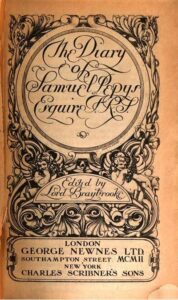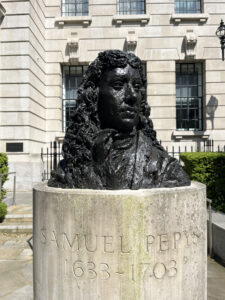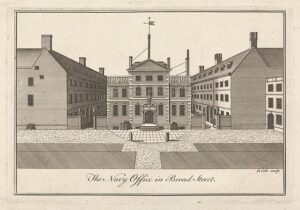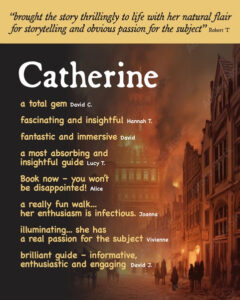Samuel Pepys’ Seething Lane: symbols, sickness, stone feasts and stories
Date post added: 19th November 2024
Legendary diarist, Samuel Pepys left us the greatest of legacies – Pepys’ Diary. The stories from his 17th-century life provides us with the most wonderfully vivid insights into London at that time. Our guide extraordinaire, David, believes it’s “the most entertaining and joyful autobiographical record ever kept.”
“I am inclined to think that Pepys when all is said is the greatest of the Londoners – a fuller, more intensely alive Londoner than either Johnson or Lamb. Perhaps he wins his pre-eminence rather by his littleness, for to be a Londoner in the highest one must be rather trivial or at least be interested in trivialities.” E V Lucas.
And for twelve years (1660-1672), this great Londoner lived on Seething Lane. This unassuming, oasis of green space in the City is the site of layers of history. Thanks to Pepys’ diaries, we still have access to the stories and experiences of that remarkable time.
What is the significance of Samuel Pepys?
Pepys’ Diary, begun in 1660, is such an impactful record of that time in London. Thanks to the quality of his writing, his incredibly honest anecdotes, illuminating profiles, indiscretions and insults truly bring that era to life.
And what a time to be alive. Samuel Pepys’ lived through, and documented the most dramatic and traumatic years of London’s life. His writings tell us about the Great Plague, the Great Fire of London, the Civil War, the trial and execution of Charles I, the Restoration of Charles II, the Anglo-Dutch War and so much more.
Beyond being a vivid storyteller, Pepys was President of the Royal Society, a naval innovator, a great friend of Sir Isaac Newton and Sir Christopher Wren, an MP, a womaniser and the list goes on.
Importantly, Pepys was a Londoner through and through. He was born in the Square Mile in 1633 and spent his early years in a house on Salisbury Court, near Fleet Street. He lived in the capital for much of his life, before dying in Clapham in 1703.
What role did Seething Lane play in the life of Samuel Pepys?
In 1660, Samuel Pepys was appointed Clerk of the Acts at the Navy Board. He was a truly innovative naval administrator. With the job came a house situated to the left of the newly created Navy Office, between Seething Lane and Crutched Friars. He worked there for twelve years, rising up the naval ranks to become Chief Secretary to the Admiralty.
Seething doesn’t refer to fury or anger. The street is named after an Old English expression meaning “full of chaff.” The air in that area would have been exactly that – full of chaff – coming from the nearby corn market in Fenchurch Street.
Experience Samuel Pepys’ Christmas morning with us on 25th December!
What are the historical landmarks related to Samuel Pepys on Seething Lane?
Seething Lane in the City of London connects All Hallows-by-the-Tower, Byward Street, with St Olave’s Church, Hart Street.
- Navy office: It was built in 1656 on the junction of Hart Street and Crutched Friars. Pepys began work there in July 1660. Incredibly, it survived the Great Fire of London in 1666, only to be burnt down in 1673. It was rebuilt soon after, perhaps by Sir Christopher Wren.
- St Olave’s Church: This was Pepys’ parish church and he spent many a morning there. There’s a slightly macabre crest of skulls above the churchyard entrance. This gave rise to Dickens’ nickname the church, ‘St Ghastly Grim’. There’s a Naval Office pew, and a bust of Pepys’ wife Elizabeth gazes down upon it. Both Samuel Pepys and his wife Elizabeth are buried in this church.
- Bust of Pepys: you’ll notice musical notes on the plinth. But he was a writer not a musician, we hear you cry. The talented Mr Pepys wrote music too and the notes carved on to his statue are the tune of his song, Beauty Retire. A little extra tidbit for you – Pepys holds a copy of this song in his most famous portrait by John Hayls, which is displayed in the National Portrait Gallery.
- All Hallows-by-the-Tower: Samuel Pepys climbed the tower and recorded his view of the Great Fire of London from there. His diary entry says:
- “I up to the top of Barking steeple, and there saw the saddest sight of desolation that I ever saw; every where great fires, oyle-cellars, and brimstone, and other things burning… … as far as I could see it”
10 engravings to find in Seething Lane garden
As you wander round the open garden, located between Seething Lane and 10 Trinity Square, you’ll see several engravings that relate to Samuel Pepys and The Great Fire of London
- Stone in forceps: oooh, Pepys did suffer from his bladder stones. The painful blighters plagued him for years. He opted for surgery at St Thomas’s Hospital – without anaesthetic of course. The stone that was removed was about the size of a tennis ball. Pepys used it as a paperweight!
- Stone feast: rightly proud of surviving this unusual surgery, Pepys held an annual anniversary stone feast to celebrate. There’s an engraved stone (not the bladder stone) to mark the feast.
- The Great Plague: this engraving shows a plague doctor carrying a winged hourglass and dressed in 17th-century protective clothing. There’s a flea-ridden rat at their feet too.
- The Great Fire of London: one stone features the city on fire, with the River Thames in the forefront. A piece of furniture is floating past. Pepys himself took some of his precious possessions to be sent to safety on a Thames barge when the fire was closing in on his home. It was Pepys who ran to the king to alert him to the potential danger of the fire. The king directed Pepys to order the Lord Mayor that houses were to be torn down to act as a fire break.
- Parmesan cheese: talking of precious possessions, Pepys buried some of them to spare them from the fire. Amongst them were his wine and Parmesan cheese! There’s a stone to mark that.
- Monkey: what’s a monkey doing on Seething Lane? According to Pepys, he found a monkey loose in his home and gave it several whacks. The monkey gets its own engraving.
- Crowley the lion: Then, on 11th January 1660 he visited the Tower of London menagerie. Crowley the lion made an impression and features on an engraving.
- Piracy, Popery and Treachery: in 1679 Pepys was arrested, dismissed from the Navy office and sent to the Tower of London charged with Piracy, Popery and Treachery. The rumour was that he’d sold state secret to the French (spoiler: he didn’t). He managed to prove his innocence and get released. Look out for the stone marking his imprisonment in the Tower.
- The King’s Head: as a child, Pepys witnessed the execution of King Charles I outside the Banqueting House in Whitehall. There’s a stone to depict the monarch’s decapitated head.
- Puppet show: Pepys’ recounts watching a wonderful Italian puppet show – likely to be Punch and Judy. There’s an engraving to mark this – and yes, it does feature a dropped baby.
Modern storytellers share Pepys’ tales
There are so many fascinating tales to tell from Pepys’ 17th-century London. One of the finest is from Christmas Day 1660. Walk that walk with us, and we’ll talk his talk, for two hours on Christmas Morning. We even end by the magnificent Christmas tree in Trafalgar Square. Join us on our Samuel Pepys’ Christmas walk!
Pepys’ eye-witness account of the Great Fire of London is the most celebrated record we have of this iconic event. Follow the action – in Pepys’ own words – as it unfolded, on Catherine’s much praised (it’s attracted rave review after rave review) On the Scene at the Great Fire of London walk. The walk begins in Seething Lane (well, it forms up at Tower Hill Underground Station) and covers all these historical landmarks.
Or for a dose of vice and sin on a weekly basis, don’t miss Ulrike’s Monday Seven Deadly Sins walk. It’s also attracted a never ending stream of rave reviews.







